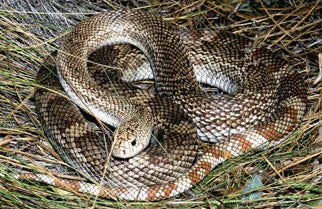SCIENTIFIC NAME:
Pituophis melanoleucus mugitus (Barbour)
OTHER NAMES:
Bull Snake, Gopher Snake.
STATUS:
Threatened in southern portion of Coastal Plain east of Mobile Bay. Also known from Southern Hilly Gulf Coastal Plain region of Russell County in extreme eastern Alabama. Individuals from Escambia and Baldwin Counties are intergradient with black pine snake, and a Fall Line Hills population in Elmore County appears to be intergradient with northern pine snake. HIGH CONSERVATION CONCERN.
DESCRIPTION:
One of Alabama’s largest (max. length approx. 229 cm [90 in.]) snakes. Dorsal color pattern of alternating dark rusty brown and cream-colored blotches often indistinct anteriorly, becoming distinct posteriorly; each scale trimmed in dark brown pigment. Individuals may vary from light gray anteriorly to rusty-brown posteriorly. Body moderately stout, but head only slightly wider than neck. A key character is the markedly pointed snout with an enlarged rostral scale for pushing into soft earth. Belly immaculate white, but darker dorsal blotches may color the sides of the ventral scales. Often makes a startlingly loud hissing sound when cornered and frightened.
DISTRIBUTION:
Florida, southern Georgia, southeastern Alabama, and extreme southern South Carolina. In Alabama, specimens have been collected from Russell, Covington, and Crenshaw Counties. Intergrades with black and northern pine snakes in southwestern and central Alabama, respectively (Mount 1975; see accounts of those subspecies).
HABITAT:
Principally found in the sandhill habitat where longleaf pine and scrub oaks (especially turkey oak) dominate and the gopher tortoise and southeastern pocket gopher occurs. Clearings and wooded areas with open canopies, especially abandoned fields, also inhabited (Mount 1975, Franz 1992).
LIFE HISTORY AND ECOLOGY:
Commonly uses burrows of the gopher tortoise and southeastern pocket gopher for shelter (Franz 1992). Diet includes the southeastern pocket gopher, immature rabbits, mice, and other small mammals, ground-dwelling birds, and bird eggs. Young may eat lizards. As with other pine snakes, spends much of its time underground. Observers have reported clutches of from four to eight large white, leathery eggs laid from June to August and hatching in September and October (Mount 1975).
BASIS FOR STATUS CLASSIFICATION:
Has always been of local occurrence and cannot be said to be common anywhere in Alabama. The sandhill habitat is being lost, altered, and fragmented at a rate dangerous to all of its biotic components (Landers and Speake 1980). Since the Florida pine snake is a well-known user of gopher tortoise burrows, it is especially vulnerable in areas where the practice of “gassing” these burrows to drive out rattlesnakes is common. Research on some ecological effects of “gassing” tortoise burrows has shown that Florida pine snakes subjected to gasoline fumes died within 24 days (Speake and Mount 1973).
Author:
D. Bruce Means






